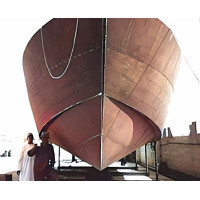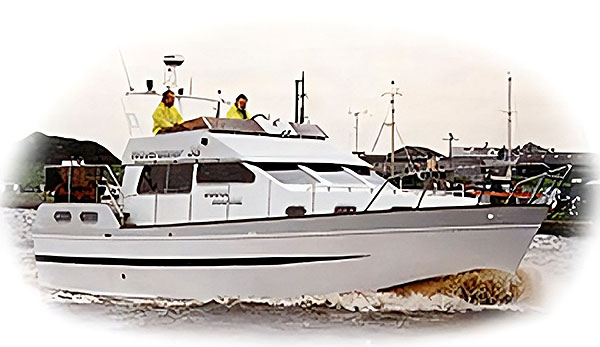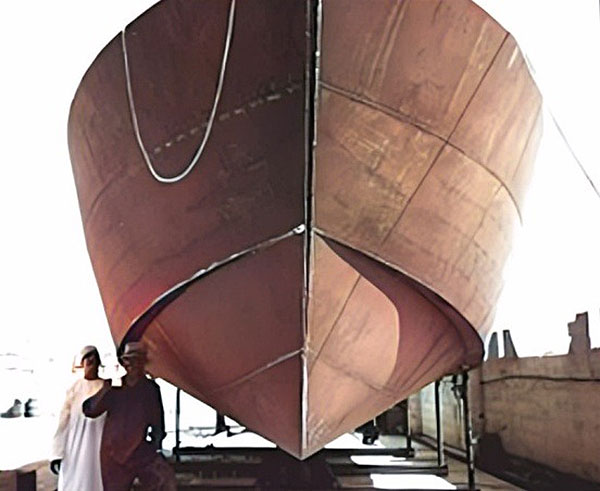Powerboat Hulls Explained

|
HULL TYPES: Power boat hulls are divided into three main types namely, Displacement, Semi-displacement and Planing hulls. Each hull type can have many sub types, which are closer to one or other end of the spectrum. Considering each hull configuration in detail will reveal its benefits and disadvantages, your choice will be influenced by your intended usage and the size of your wallet. The size of your intended power boat will also be a factor in your choice of hull type; for instance if you are considering a large power boat (large is a relative term) then you will be less likely to choose a full planing hull. Large fast planing hulls require large expensive engines and use large amounts of fuel and operating costs are high. Below are the outlines of the qualities of the various types of power boat hulls. Starting at the Displacement end of the range, these were the first to be developed and to go back to the beginning of time; the original log canoe and even the ark (as far as we know) were all displacement hulls.
MEDIUM DISPLACEMENT: Once the most economical speed is achieved, it takes a considerable amount of power to make a displacement hull go faster. When this type of hull is over driven then the stern will drag in the water and usually create a large stern and bow wave. The boat may reach such an extreme bow high, stern down angle, where water could come in over the stern and swamp the vessel. Displacement hulls should not be driven much in excess of their "hull speed". For vessels ranging in size from 30 ft / 9.1 M to 60 ft / 18.3 M waterline length, you should consider displacement hulls only if your speed requirement is around the 6 to 11 knot mark respectively. For higher speeds consider Semi-displacement or Planing hulls. One important factor is that Displacement and Semi-displacement hulls are generally considered better ‘Sea Boats’ and are more suitable for serious offshore cruising than the planing hull type. As with heavy displacement hulls, medium displacement hulls are not so affected by weight as the semi-displacement and planing hull types.
SEMI-DISPLACEMENT or SEMI-PLANING HULLS:
The semi-displacement hull will out perform the displacement ‘Hull Speed’ rules and will accept additional power and convert it to additional speed however there are limits to this benefit. Generally speaking for vessels with 30 ft 9.1 M to 60 ft / 18.3 M waterline length, you should only consider Semi-displacement hulls if your speed requirements do not exceed 12 to 16 knots. As you have seen with displacement hulls additional power is wasted, however with semi-displacement hulls often the extra power may be utilised to advantage. If you already have access to a certain size of engine; or you already own the engine(s), then this factor may assist you in making the decision as to which type of hull best suits your situation As with Displacement hulls, Semi-Displacement hulls can be driven harder, but at the expense of greater fuel consumption and again the stern will tend to dig in at higher speeds. Existing semi-displacement hulls can be made to achieve extra speed with the same horsepower by adding trim tabs or planing wedges at the stern. The trim tabs and the wedges will be fixed after trials are completed to establish the best angle. In no case should you try to improve the performance of your hull in this manner without the assistance of professional advice. If you are building a Semi-Displacement hull, you should try and keep the weight to reasonable levels. The Semi-Displacement hull is a good weight carrier but it takes additional power and fuel to get the best out of an over weight boat of this type. Finally this is the type I would personally choose when planning to undertake extended cruising, that is cruising that regularly involves cruising distances of over 100 miles from home base.
PLANING HULLS: You will often hear the terms 'Deep V' or 'Moderate V'. These terms are meant to convey the amount of V at the transom and in addition to this they do express two different types of hull. A true 'Deep V' hull will have 20 to 24 degrees of V at the transom while a Moderate V hull is one with around 15 degrees of V at the transom. The area in between 16 and 19 degrees can be described either way by the particular designer or builder of the particular boat. Suffice to say that a hull with a V at the transom or 20 degrees or over can be safely classified as a deep V and in my opinion should not be described as a long distance or passage making cruising powerboat.
When deep V hulls were introduced they were touted as the last word in planing hull design. These hulls do perform well at high speeds in rough water which is one reason that they are so successful as racing powerboats. Deep V planing hulls, depending on the particular design, can be driven at speeds in excess of 50 knots, however most are designed to cruise at speeds between 30 to 35 knots. Modern computers can accurately estimate the power requirements and speed expectations of all hull types and are especially helpful in the case deciding the power needed for individual planing hulls. Planing hulls are very popular, they make great pleasure boats if you are prepared to install sufficient power and pay the larger fuel bills. Planing hulls do not like being operated at low speeds; they throw a most unfriendly bow wave. Planing hulls are not the best of sea boats especially in severe conditions. For local and coastal cruising it is worth noting that a planing hull may allow you to get home before the bad weather arrives. If your type of cruising lends itself to the advantages of a planing and if the disadvantages including high cost of operation do not bother you, then by all means consider this type. In this case a moderate V hull is recommended. On no account select a planing hull if you intend to operate your boat in the canal systems of USA or Europe. These hulls are not suitable if your cruising area is restricted to low speed operation. Our stance here at Fine Line Boat Design is that with the large amount of fuel and resultant pollution caused by planing hulls when compared to the displacement hull form shape is unacceptable and thus we no longer sell planing hulls.
PLANING FLATS AND STRAKES: ROUND BILGE: POWER CATAMARANS: |
Horsepower Vs Speed
|
Displacement and Planing Hulls |
| Design | Hull Type | Displacement | Engine H.P. | Speed knots |
|
| lb | kg | ||||
| Longboat 21 | Displacement | 3000 | 1360 | 20 to 40 | 6 to 8 |
| Waverunner 22 | Semi-Displ. | 6500 | 3000 | 20 to30+ | 6 to 10 |
| Waverunner 25 | Semi-Displ. | 9800 | 4450 | 33 to 75 | 7 to 12 |
| Coastworker 25 | Semi-Displ. | 8500 | 3860 | 100 to 130 | 10 to 12 |
| Coastworker 25 | Displacement | 8500 | 3860 | 50 | 8 |
| Waverunner 28 | Semi-Displ. | 10000 | 4550 | 33 to 120 | 8 to 12 |
| Coastworker 30 | Displacement | 14480 | 6570 | 65 to 100 | 8 to 10 |
| Coastworker 30 Mk II | Semi-Displ. | 13850 | 6300 | 85 to 180 | 8 to 13 |
| Waverunner 34 | Semi-Displ. | 17000 | 7710 | 50 to 150 | 8 to 12 |
| Waverunner 38 | Semi-Displ. | 30000 | 13610 | 120 to 185 | 9 to 12 |
| Cat 39 Power/Sailor | Twin Hulled | 24640 | 11200 | 2x50 to 2x180 | 8 to 25 |
| Waverunner 40/42 | Displacement | 28000 | 12727 | 80 to 100 | 8 to 10 |
| Waverunner 44 | Semi-Displ. | 44000 | 20000 | 120 to 250 | 10 to 14 |
| Waverunner 45 | Semi-Displ. | 46000 | 20865 | 120 to 250 | 10 to 15 |
| Custom Cat 46 | Twin Hulled | 34000 | 15420 | 2x80 to 2x350 | 12 to 24 |
| Waverunner 52 | Semi-Displ. | 58000 | 26310 | 250 to 450 | 10 to 14 |
| Waverunner 55 | Semi-Displ. | 57600 | 26130 | 260 to 450 | 10 to 15 |
| Waverunner 65 | Semi-Displ. | 81540 | 37000 | 250 to 500 | 10 to 16 |
Displacement is an AVERAGE ESTIMATED DISPLACEMENT of a amateur built vessel.

 HEAVY DISPLACEMENT:
HEAVY DISPLACEMENT: This Waverunner 38 is a typical semi-displacement powerboat. This version performs best at speeds between 8 and 14 knots.
This Waverunner 38 is a typical semi-displacement powerboat. This version performs best at speeds between 8 and 14 knots.